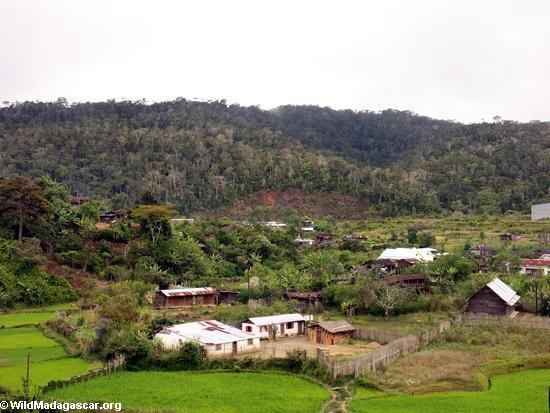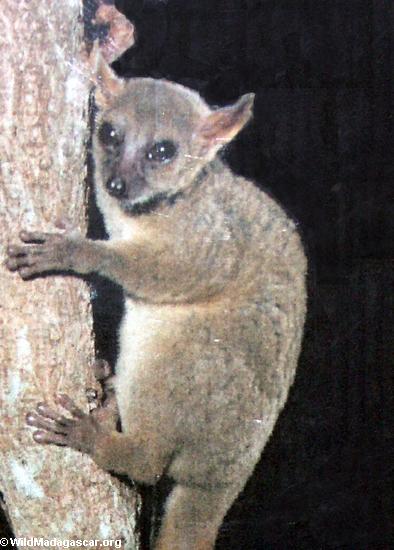Two tiny lemur species discovered in Madagascar
Field Museum release
August 9, 2005
Finding follows discovery of two other new species of lemurs earlier this year.
CHICAGO–German and Malagasy primatologists have discovered two new species of lemurs, naming one of them after Steve Goodman, a Field Museum scientist who has devoted nearly two decades to studying the animals of Madagascar.
Lemurs in the wild are found only in Madagascar, one of the most important conservation hotspots on Earth. Lemurs are the last living link to ancient primates that have a common link to the primate lineage that evolved into humans. Therefore, they are extremely important to understanding the origin, evolution and ecology of human beings.
Finding a new species of lemur is rare; this discovery brings the number of known lemur species from 47 to 49. Many species have become extinct since humans first populated Madagascar about 1,500 years ago, and lemurs are considered the most endangered of all primates. The new lemurs were discovered by scientists at the German Primate Center (DPZ) and the University of Göttingen and are described in the current issue of the journal Primate Report (http://www.dpz.gwdg.de/infra/primrep.htm). The findings will be presented on August 10 to the scientific community at the Congress of the European Federation for Primatology in Göttingen, Germany.
 The newly discovered Microcebus lehilahytsara is a distant relative of man’s ancestors and therefore important to understanding human origins and evolution. Photo by Robert Zingg
| ||
“The discovery of these two new species highlights the fact that we still have a lot to learn about patterns and causes of biodiversity, even among our closest biological cousins,” says Peter M. Kappeler, Department of Behavioral Ecology and Sociobiology at DPZ in Göttingen. “Even though Steve Goodman and others have sampled the remotest corners of Madagascar, we are still not near a final count for lemurs and other species found there.”
Detective work
The first new lemur was discovered when scientists analyzed and compared morphological, genetic and behavior data from distinct populations of the giant mouse lemur, Mirza coquereli.
Traditionally, only one species of giant mouse lemur has been recognized. Two distinct populations of Mirza coquereli were known to occur on the island, one in the west and the other in the north. Fieldwork by a DPZ team led by Kappeler revealed morphological and behavioral differences between members of these two populations of Mirza coquereli. This suggested that the two populations actually represented distinct species. Comparative genetic analyses by Christian Roos confirmed the distinctiveness of the two populations and led to the description of the northern population as a new species, Mirza zaza. The two species have been separated for about 2 million years.
Mirza zaza is nocturnal and the size of a gray squirrel weighing about 10 ounces (300 grams). It has a long bushy tail, relatively small ears and large testes, which are suggestive of a promiscuous mating system.
“Zaza” is the Malagasy word for “child” or “children.” This name was chosen because the new species is the smaller of the two Mirza species. Also, with this name the new lemur is dedicated to Madagascar’s children, to remind them of their responsibility for preserving the island’s unique biodiversity for future generations.
Goodman’s mouse lemur
The genetic analyses to determine the taxonomic status of the two Mirza populations unexpectedly revealed the existence of a new species of mouse lemur, Microcebus lehilahytsara. Earlier this year, Robert Zingg and Samuel Führer brought nine living individuals from Andasibe to Zoo Zürich in Switzerland, where additional morphometric and genetic analyses confirmed their separate taxonomic status.
The genus Microcebus traditionally has been comprised of eight species, six of which were described from western Madagascar only in the past decade. Now there are nine species of Microcebus.
 Village near Andasibe National Park in Madagascar. Andasibe is Madagascar’s most accessible and most popular park. It is home to the famed Indri, a lemur that sings like a whale. |
|
Genetic analyses also revealed that this new mouse lemur from Andasibe, a popular tourist site in the eastern rainforest, diverged more than 2 million years ago from other mouse lemur populations in the region.
Microcebus lehilahytsara, the newly discovered species, lives in eastern Madagascar’s rainforest. Only a little bigger than a big mouse, this arboreal, nocturnal mouse lemur has short, rounded ears, with a white stripe on the bridge of its nose. Its short, dense fur is bright maroon with an orange tinge on the back, head and tail, turning creamy white on its stomach.
Lehilahytsara means “good man” in Malagasy. The German primatologists chose this name to honor Steve Goodman, scientist with The Field Museum in Chicago and WWF in Madagascar. “Goodman’s field research in all remote parts of Madagascar has contributed enormously to our knowledge about the diversity of Madagascar’s unique and threatened fauna and flora,” Kappeler says.
 Mirza coquereli, a lemur closely related to the newly discovered Mirza zaza. | |
“It is truly an honor to have such an animal named after me,” Goodman says, “but this is really a joint tribute to all of the scientists and students who have taken part in our multidisciplinary surveys over the past 16 years.”
Little is known about the ranges and population numbers of the two new lemur species. The habitat of Mirza zaza is already highly fragmented. Microcebus lehilahytsara is found within a protected reserve, but the surrounding rainforest is also heavily threatened by slash-and-burn activities.
“It is simply remarkable that M. lehilahytsara was obtained at Andasibe, a protected area of forest that is considered one of the biologically best known sites on the island and is the most heavily visited by ecotourists,” Goodman says. “The fact that such an area holds a primate previously unknown to science underscores how much still needs to be done to document the biota of this extraordinary island.”
Goodman and Jonathan Benstead are coeditors of the 1,700-page The Natural History of Madagascar (University of Chicago Press, 2003), the definitive book on the world’s most important island in terms of ecology and conservation.
Related articles:
- Seeking the world’s strangest primate on a tropical island paradise off Madagascar
- Lemur hunting persists in Madagascar, rare primates fall victim to hunger
- The Giant Jumping Rat, another peculiarity from Madagascar
- Dancing lemur attracts tourists to island of Madagascar
 Save Madagascar T-shirt Sifaka lemur dancing shirt |
 Madagascar Wildlife T-shirt Wildlife of Madagascar |
 Save Madagascar T-shirt Wildlife of Madagascar |
 Wildlife of Madagascar Poster in Malagasy and English |